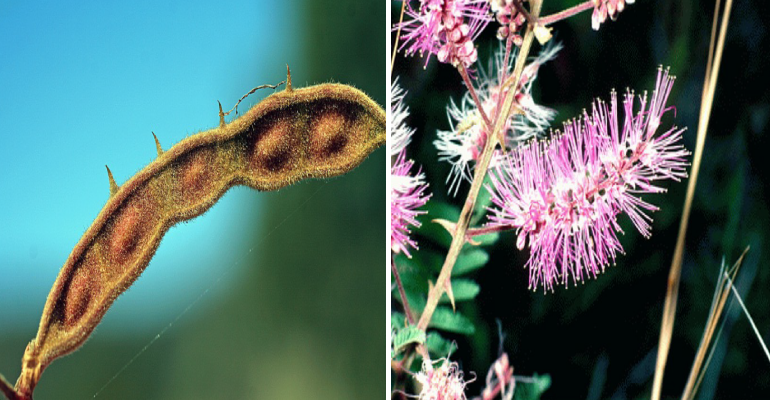
The Velvetpod Mimosa (Mimosa dysocarpa) is an extremely drought and heat tolerant legume plant that is native to Arizona, New Mexico, and Texas. It blooms during the hottest part of the summer. It occurs mainly along arroyos and washes, 3500-6500 ft. elevation.
The mimosa is a woody shrub that grows three to six feet tall. The branches have large, sharp thorns. The flowers are showy but misleading because you see the flower filaments not the petals. The petals are very tiny and fused together. (See photos here) Fresh flowers are magenta to deep pink, but fade to light pink and white as they age. The leaves are fuzzy.
The pollen is a mild allergen. Butterflies, bees, birds, and moths are the principal pollinators.
After the flowers are pollinated, the fruit is a one- to two-inch-long bean covered with tiny hairs which look like velvet, hence the name. The bean pod is also protected by four large thorns. These beans are a favorite of quails. The plant is a favorite of Coues white-tailed deer in the Santa Rita Mountains of Arizona (source).
The velvetpod mimosa is often used in xeriscape gardens.
The velvetpod mimosa is in the Mimosoideae subfamily of the Leguminosae family (Fabaceae). For some perspective, here is what the Arizona-Sonora Desert Museum says about this plant group:
“Legumes are a very large family of 16,000 species in nearly all of the world’s habitats. Champion drought tolerators, they are most abundant in the arid tropics. Their prevalence in the Sonoran Desert flora (for example, there are 53 legume species in the Tucson Mountains, 8% of its plants) reflects this desert’s tropical origin. North of the Mexican border most of the common Sonoran Desert trees are legumes.”
“The family was named Leguminosae for its fruit, which in most species is a legume (the technical term for bean pod, a single-chambered capsule enclosing what appears to be a single row of seeds that is actually two rows — alternate seeds are attached to opposite halves of the pod). There are three subfamilies with flowers that look very different from one another at first glance, but arose from a common pattern: Caesalpinioideae, Faboideae, and Mimosoideae.”
Some of my other articles about plants in the legume family are:
- Desert Ironwood
- Mesquite trees provide food, fuel, medicine, and more
- Palo Verde trees about to turn the desert golden
Note to readers:
Index with links to all my ADI articles: http://wp.me/P3SUNp-1pi
My comprehensive 28-page essay on climate change: http://wp.me/P3SUNp-1bq
